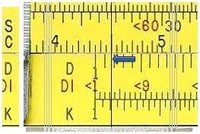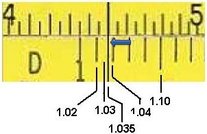Analog vs digital
The history of computing is divided into two major categories: digital vs analog calculators.
The digital mechanical calculator carries out only the four operations, the analog slide rule carry out the functions of a modern scientific calculator, except adding and subtracting.
In analog mode the operations are the result of a sum of measurements. The numerical quantities are represented by means of continuous physical quantities (scales).
It works simulating "by analogy" the operation to be performed.
To clarify: if I put 10 stones of 100 grams each on the balance I will read 1 kg. If I add other 10 I will read 2 kilos, as long as the scale is accurate and if I am able to read it properly.
Two kilos are equivalent to 20 stones. I performed 10+10 in an analog way.
With the digital system the numbers are represented by single units, such as the bead of the abacus or a number.
Counting the same stones I will have first 10 and doubling them 20. I have calculated digitally and the result is independent of the accuracy of the balance and the uniformity of the weights. Impossible to make mistakes.

This anemometer shows the same data represented in both ways. The needle measures a distance and is less easy to read than the digital information, but it is more intuitive to notice the measured quantity. It must be remembered that 15.9 m / s indicates a strong wind, but the position of the needle over half scale tells us the situation immediately. For this reason the speedometers of the cars are always of the traditional type.
Because the difficulty of reading the results seems inconvenient to use the analog system, but the logarithms permits to perform complex operations only marking them in form of scales. With the abacus, and later with mechanical calculators, you can perform only addition and subtraction. Multiply or extract roots in digital mode requires a long and tedious calculations.
Reading the display
In the digital display the result is immediately understandable while in the analog one is a measurement and must be interpreted.
Below the number 1,035,000 is expressed clearly.

In digital the result is easy to read ...
Let's look at the same number on the slide rule. The reading is inaccurate but the engineers had such a good practice that errors hardly exceeded 2%. It was necessary to approximate, of course in excess, and the objects of the past were very robust creating the myth of the "Olde Good Things".

1.035.000 on the slide rule can hardly be seen.


... and also watching carefully is very difficult to read
The computer, derivative of the digital mechanical calculators, has a history of its own. It is interesting to remember that the binary system was invented by Leibniz in 1679, just thinking to its use in a super calculator. The first programmable computer, with punch cards, was built in 1801 by Jacquard for the production of fabrics. Modern technology has ancient roots.
Links: Analog and digital on Wikipedia.
© 2004 - 2025 Nicola Marras Manfredi
